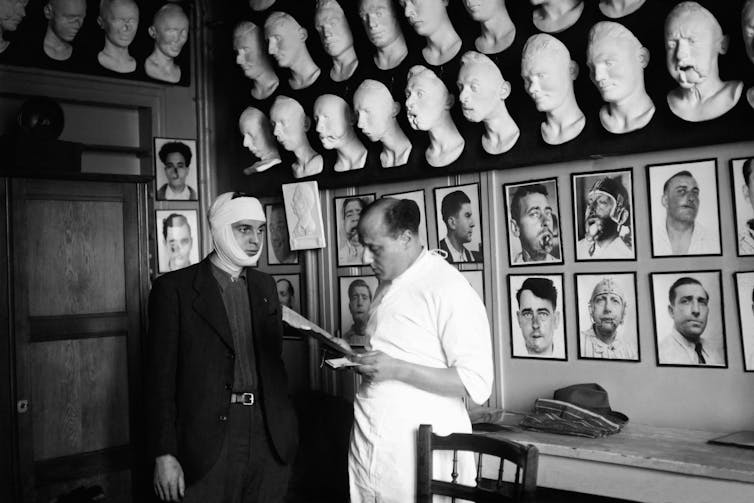The pursuit of eternal youth goes back centuries. Modern cosmetic surgery is turning it into a reality – for rich people
https://theconversation.com/the-pursuit-of-eternal-youth-goes-back-centuries-modern-cosmetic-surgery-is-turning-it-into-a-reality-for-rich-people-257969 Share article
Kris Jenner’s “new” face sparked myriad headlines about how she can look so good at 69 years old. While she’s not confirmed what sort of procedures she’s undergone, speculation abounds.
As a US reality TV personality, socialite and Kardashian matriarch, Jenner has long curated her on-screen identity. Her fame and fortune are intimately tied to a multinational cosmetics industry that has, for centuries, bartered in the illusion of timeless beauty.
The pursuit of cosmetic enhancement can be traced back as far as Ancient Egypt, reminding us the desire to look younger is hardly new.
But while many women try in vain to battle the ageing process, Jenner is an example of someone who’s actually succeeded, at least visually. What does that mean for the rest of us?
Decades of surgeries
Modern cosmetic plastic surgery has its roots in compassion. It was developed to help disfigured first world war soldiers rebuild their faces and identities.
But this origin story has been sidelined. Today, aesthetic procedures are overwhelmingly pursued by women and marketed as lifestyle enhancements rather than medical interventions.

Plastic surgery, once considered extreme or shameful, began to gain popularity in the 1960s, and is now widespread.
Hollywood has long played a role in shaping these standards. During its Golden Age, stars like Marilyn Monroe and John Wayne are reported to have undergone cosmetic surgeries – rhinoplasty (nose jobs), chin implants, facelifts – to preserve their screen personas.
Even before Instagram, before-and-after images were a cultural obsession, often used to shame or expose.
From taboo to trend
The digital age has further normalised cosmetic enhancements, with social media influencers and celebrities promoting procedures alongside beauty products.
It’s estimated Jenner spent upwards of US$130,000 (around A$200,000) on cosmetic interventions, resulting in a look that some media outlets suggest places her in her 30s.
There’s been similar speculation about Lindsay Lohan, Christina Aguilera and Anne Hathaway, though none of the women have confirmed anything themselves.
On Jenner, social media users are split. Some offer aspirational praise (“If I had the money, I’d get it all done!”), while others criticise her rejection of “ageing gracefully”.
Today, celebrities increasingly control the narrative. Jenner has embraced her past cosmetic transformations, sharing them openly on social media and in interviews. The taboo is evolving.
Yet many stars, including Courtney Cox, Ariana Grande, and Mickey Rourke, have spoken openly about regrets and the psychological toll of these procedures. Even with agency, the pressure remains immense.
Youth as a cultural ideal
This obsession with agelessness reflects a deeper societal discomfort with visible ageing, particularly in women.
Celebrities, with access to elite medical professionals and procedures, seem to cheat time.
Yet the outcome of is often disorienting: when Jenner appears younger than her children, the generational lines blur.
This erasure of age difference entrenches youth as an end in itself. It also destabilises how we perceive kinship and mortality.
Supermodel Bella Hadid has said she regrets getting a rhinoplasty as a teenager. Of Palestinian descent, she said “I wish I’d kept the nose of my ancestors”.
In my own research, I’ve argued cosmetic enhancement is tied to a cultural denial of death.
The ageing isn’t the problem – it’s our refusal to accept it.
The desperate clinging to youth reflects a collective resistance to change. Celebrity culture and consumer capitalism exploit this vulnerability, making age a problem to be solved rather than a life stage to be honoured.
We should mourn our ageing, not erase it. In another world, we could witness it, share it, and celebrate its quiet, powerful beauty.
So what about us?
But that’s not the world many live in, and the pressure extends beyond Hollywood.
With filters, apps, and social media platforms, ordinary people also curate and enhance their images, playing their part in a fantasy of perfection.
A recent study looked at the way young Australians use selfie editing tools. It found the widespread use of such apps have a significant effect on the body image of young people.
The line between self-care and self-deception has never been blurrier. We all want to present the best version of ourselves, even if reality slips into illusion.
So while women have long tried to outrun visible ageing, whether that be through anti-wrinkle creams or more invasive means, Jenner is an example of something relatively rare: a woman who’s actually managed to do it.
In doing so, she and her celebrity counterparts set a new youthful beauty standard in what ageing should (or shouldn’t) look like.
And while that standard may be felt by a variety of women, few will be able to achieve it.
Extremely wealthy beauty moguls like Kris Jenner can afford elite treatments, while most people face growing financial pressure and a cost-of-living crisis. The divide isn’t just aesthetic – it’s economic.
Beauty, in this context, is both a product and a privilege.
And of course, judgement of women’s appearances remains a powerful force for discrediting their political, social, and moral worth. For every bit of praise there is for Jenner’s “youthful” appearance, there are videos claiming she’s “ruined her face” and questioning of whether she should spend so much money on such a cause.
As long as gender inequality persists and beauty remains a currency of value, the pressure to conform will endure.
